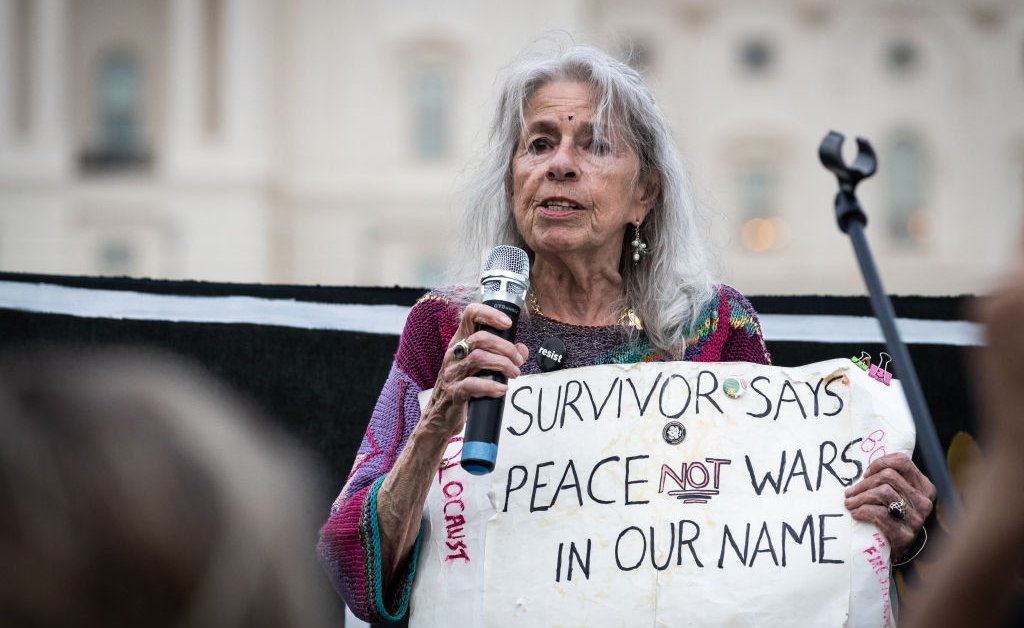
“Educate them about the Holocaust.”
That’s the rallying cry for many of those who feel shocked by skyrocketing antisemitism and Islamophobia on college campuses and K-12 schools. Learning about the Final Solution, the reasoning goes, steers young Americans against bigotry.
[time-brightcove not-tgx=”true”]As the grandson of Auschwitz and Buchenwald survivors and an educator and documentary filmmaker who often tells Holocaust-related stories, I used to subscribe to this notion. But I’ve come to realize that despite being embedded in K-12 social studies, world history, and English literature curricula throughout the country, Holocaust education has failed to uproot hate and ignorance.
Social media, where teens spend about five hours a day on average, teem with “Holocaust denial and distortion,” as well as antisemitic and Islamophobic conspiracy theories. The latest, for instance, falsely blames the Jews for Congress’ TikTok crackdown. No wonder K-12 schools’ incidents of antisemitism and Islamophobia have skyrocketed, even before the Israel-Hamas War erupted and broke the hydrant of hatred wide open.
Read More: Who Needs Holocaust Remembrance Day in 2024?
In recent weeks, a flood of Israel-Hamas War-related hostility has forced an increasing number of university administrations around the country—such as Columbia, the University of Texas at Austin, and the University of Southern California—to summon the police in an attempt to quell student protests. Columbia moved all classes online on the eve of Passover, suspended some protesters, and threatened to expel those who’d occupied a campus building. USC revamped its commencement plans. And although most protests have played out as legitimate political activism reminiscent of the 1960s student movements, some have reportedly crossed the line into antisemitic and Islamophobic vitriol and violence.
On campuses and schoolyards, Jews and Muslims have suffered physical and psychological harm—from being jabbed in the face by a flagpole and requiring hospitalization to being called “terrorists” and needing mental-health counseling. The U.S. Department of Education’s Civil Rights Office has been investigating several universities and school districts.
Holocaust education, in its foundational intention, was supposed to nip much of this in the bud. Taught at elementary, middle, and high schools throughout the country since the 1970s, it’s been positioned for wide impact. Twenty-six states require the instruction of the Holocaust. Most of the other states have funded commissions and councils to advance opportunities to educate students about the Nazis’ murder of 6 million Jews and millions of people with disabilities, homosexuals, and Romani people, among other groups.
Historically, conservatives and liberals alike have embraced Holocaust education. The 2020 Never Again Education Act passed by a 393-5 vote at the U.S. House of Representatives and unanimously at the U.S. Senate. Further setting Holocaust education up for success, nonprofits ranging from USC’s Shoah Foundation in Los Angeles to the Holocaust Memorial Museum in Washington, DC, have been supporting teachers for decades. Organization like Pittsburgh-based Classroom Without Borders have taken educators to the sites of Nazi death camps in Eastern Europe. On May 5, March of the Living is sending teachers and students, as well as the chancellors and presidents of SUNY (State University of New York), Towson, and other universities, to Poland. Stateside, 85 Holocaust museums and memorials have hosted countless school field trips.
Yet, Holocaust education has fallen far short even of its fundamental goal to raise awareness. Polls show young Americans lack “basic knowledge” about the Holocaust. About two-thirds know nothing or very little about Auschwitz and grossly underestimate the number of Jewish victims.
Alarming conversations I’ve had with students make it impossible for me to ignore these statistics. Following a university screening of a rough-cut of one of my documentaries, “Cojot,” two freshmen sheepishly told me they’d “never heard of this.” I assured them few have heard of French business consultant Michel Cojot’s quest to kill his father’s Nazi executioner.
Shaking their heads, the freshmen said they’d “never heard about any of this.”
They were talking about the Holocaust.
The encounter sent me on a mission of my own: help fulfill Holocaust education’s promise. I started by contemplating what knowledge, insights, and skills their students must obtain to put antisemitism and Islamophobia in the rearview mirror.
A couple of observations informed my thinking about the knowledge part of the equation: Traditional Holocaust education’s emphasis on disseminating historical facts has generated disappointing results and, in the long run, even A-students retain only a fraction of the information they absorb in school. They ofttimes memorize a lesson, regurgitate it on a test, then discard it from their brains.
So I focused on insights and skills, which tend to be stickier. An understanding of how democracies function and malfunction can stay with children and adolescents for life, sharpening their worldview and lending them a moral compass. Critical thinking, fact-finding, and active listening can boost empathy and productive civic discourse, enabling students to better navigate the present, past, and future.
In building this approach, I combined old methods in a new way. For a pedagogical anchor, I turned to practitioner inquiry, also called action research. This well-regarded yet underutilized professional development (PD) mechanism helps K-12 teachers examine and improve their practice. I hypothesized that although it was rarely if ever used in such a way, practitioner inquiry would upgrade Holocaust education when fitted with four lenses: contextual responsiveness, which enables educators to make their lessons relevant to the here and now; trauma-informed, which steers them away from age-inappropriate material and assists them in identifying and coping with trauma in their classrooms and schools; apolitical educational equity, which values every child and adolescent; and asset-based, which directs teachers’ attention to their students and communities’ strengths.
To test this properly, I founded the nonpartisan, pedagogically orientated Holocaust, Genocide and Human Rights Education Initiative at Penn State. It provides PD programs in five states and counting to K-12 educators, many of whom know what but not how to effectively teach difficult topics.
The first rule of the initiative—to borrow a phrase from David Fincher’s “Fight Club”—is you do not have to talk about the Holocaust. Research my colleagues and I have conducted indicates the effective instruction of any difficult topic, be it slavery or evolution or gender, can get at the Holocaust’s underlying causes.
Participants in the initiative’s programs, who represent various roles, disciplines, and grade levels, choose a difficult topic from their curriculum or community. They learn to teach it confidently by conjuring up compelling questions, finding credible sources, collecting and analyzing data, examining the findings with experts and colleagues, drawing up an implementation plan, and applying it in their classrooms and schools. Thus, they meet their students where they are in authentic ways.
Our participants, who include nearly as many music and biology as social studies and English teachers, empower their students to come up with their own guiding questions and seek the truth and its implications for themselves. To teach in this unconventional manner, educators must shift from acting as sages on the stage to setting the stage for their students’ experiential learning.
This mindset change typically requires a mind-twisting effort. Why would teachers—already overburdened meeting state, district, and parental expectations—add this to their trays? Their motivations range from resetting the tone in their classroom to removing the perception of indoctrination to redefining student success. A longtime elementary school teacher, for instance, aimed to make her Civil War lessons more thought-provoking. “I was interested in ways to help my students think for themselves,” she told me. And a mid-career middle-school teacher sought to instill empathy in her seventh-graders. Referencing Jim Crow and Nazi propaganda, she challenged her students to investigate her thesis that “if you spend enough time talking negatively about people, you start to believe it.”
She tasked her students with logging “everything they said and heard in one day.” The hands-on assignment opened the seventh-graders’ eyes and, eventually, hearts. They reported hearing numerous hurtful judgements and “conversations about fighting,” the middle-school teacher said. “The data collected were overwhelmingly negative.” In the following weeks, the students “wanted to talk about it more” and grew to “understand why they do what they do and reassess what they say about each other.”
Much of K-12 looks far into the future. Ace biology or math now and become a doctor or coder later. Difficult topics inquiry offers students immediately useful takeaways. The empathy and active-listening skills they develop can enrich their inner and social lives. The two-way respect they forge with peers and adults can bolster their communications and self-esteem.
To give students a brighter outlook, individually and collectively, and fortify our democracy, we must reinvent how we teach difficult topics. We must trust students to chart a constructive course for themselves and society. This will forge a sense of control that can propel students on journeys of discovery, during which they learn to conduct primary research, triangulate the information they gather, seek multiple perspectives, and dialogue and debate with classmates. Ultimately, too, it would prompt our next generation to wonder why any student ever chose echo-chamber scorn over face-to-face, heated-yet-respectful civic discourse.




























